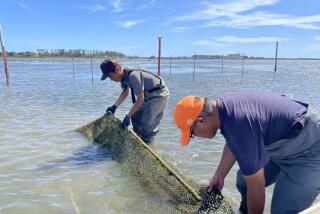Lobster Industry Is in Hot Water
- Share via
FRIENDSHIP, Maine — It’s summer on Maine’s coast, but this morning Philip Bramhall pulls on a hooded fleece shell with his rubber overalls to heave 50-pound lobster traps around his boat’s deck.
He doesn’t mind the chill and wet fog. Lobsters like cold, and Bramhall likes lobsters.
Maine’s lobstermen have been hauling up phenomenal numbers for almost 15 years. Their 62.3 million pounds in 2002 set a record -- triple the typical catch during the 1980s. That’s more than $200 million worth of lobster and by far the dominant share of the Northeast’s most valuable fishery. But can it last?
Starting in the late 1990s, in the southern reaches of its near-shore commercial range, the big-clawed American lobster -- prized for its delicate, sweet flesh -- has been withering at an alarming rate from New York state to Massachusetts. Signs of decline have now crept as far north as the southern Gulf of Maine, the edge of the country’s lobster breadbasket.
Finding an explanation has been a problem. Government biologists have said the lobster is overfished off the Northeast, but that doesn’t account for Maine’s extravagant abundance. Researchers in various localities have blamed the trouble on diseases, pollutants and predators. But that fails to explain any larger pattern.
In recent months, however, a scientific consensus has begun to congeal. It centers on the familiar process of global warming.
The theory holds that warming is killing off the American lobster in its southern near-shore range, where it lives near its heat tolerance. In Maine, where it is well within its comfort zone, more warmth -- up to a point -- may make it proliferate.
If temperatures rise too high, though, even Maine may turn less hospitable to lobster, some researchers say. Last year’s state catch fell back almost 14% to 53.9 million pounds.
“We’re hoping our cold water will keep it to the south, because so much of our economy is dependent on lobstering,” says Pat White, chief executive of the Maine Lobstermen’s Assn. and an overseer of the fishery for a joint committee of Northeastern states. “If it hit us, it’d be a disaster.”
*
In early America, demand was low, and lobster was plentiful. In those days, it was fed to servants and prisoners. Sometimes it was just thrown down as crop fertilizer. Bramhall’s grandfather told him that even in his time, bars sometimes served lobster like popcorn.
Discovered by high society, lobster began finding its way to many well-appointed tables in the 19th century. Villages like Friendship started to shape their economies and regional identity around lobstering. Five generations of Bramhalls have fished lobster here, mating their livelihoods to the fickle animal’s reproductive cycles.
Since around 1990, times have been fat for Friendship and much of Maine’s coastline. Today, most families in this village of about 1,200 live off lobster. They are fishermen, dealers, trap makers, boat builders, marine outfitters. Potentially lucrative lobstering tempts teenagers from high school. Wire traps are neatly stacked like cordwood in yards and fields. They rise high from boats and docks like boomtown oil rigs, sometimes reeking of dead fish or seaweed.
Bramhall is grossing about $150,000 during the April-to-January lobstering season, almost double his former business. He has added a family room and two-car garage to his house.
He shrugs off government biologists who predict a lobster drop-off, based on arcane calculations concocted in stuffy offices. “They don’t see what we see out here when we haul up a trap. You might see 25 to 30 small lobsters in it,” he says.
Not long ago, John Makowsky used to wrestle up traps like that from the bottom of western Long Island Sound near New York City. One calm day in late September 1999, his traps emerged full, but almost all the lobsters were dead. A fourth-generation lobsterman, he knew something was very wrong.
“Within the first few strings of traps that I hauled up, it felt like a cannonball had hit me in the chest,” he says.
By day’s end, he had landed almost 400 lobsters. Only 30 or so were alive -- and barely. The next day was no better, or the next, for Makowsky and the other lobsterman in the western sound. Within weeks, almost the whole stock -- as many as 6 million lobsters -- was inexplicably, inconceivably gone.
It was awful, but at first it appeared unique. Within months, though, other distress seemed to be spreading around the fishery. To the northeast, boats began pulling up more and more lobsters with bumpy black scars from a bacterial disease that could bore right through their shells. They were alive, but no one would eat the nasty-looking things.
By 2000, the catch off eastern Connecticut and Rhode Island was crashing. The take in Massachusetts began to shrink the next year and, farther north in New Hampshire, a year later. Something was unfurling in a striking pattern, and it seemed to be migrating north.
Researchers fingered different culprits. On western Long Island Sound, it turned out that the dead lobsters were infected with a parasitic amoeba. But was it the killer or just the colonizer of animals weakened by something else? No one knew.
Other suspicion turned on mosquito pesticides sprayed to control West Nile virus, which killed several people that season in its first U.S. appearance. About 1,100 lobstermen collectively sued pesticide makers, claiming $300 million in losses. The case awaits trial.
Scientists also found more lobster predators, like striped bass, in waters south of Maine. Maybe they were devouring more lobsters, but that didn’t account for the outbreaks of disease.
By official standards, lobstermen are overfishing Northeastern waters. They are leaving too few lobsters to breed later generations, even in Maine, according to the calculations of government biologists. Some predict drastic decline in Maine’s future.
For the moment, though, something seems to be shielding Maine. The more southern a state, the more its catch has dwindled, according to an Associated Press analysis of the latest complete state data. New York’s take collapsed by 75% between 1999 and 2002. Moving progressively north, the drops attenuate: Connecticut, 59%; Rhode Island, 53%; Massachusetts, 14%; New Hampshire, 3%.
Government estimates of the lobster population nosedived during the same period. The estimate slipped 14% below its historical average in Massachusetts’ near-shore waters north of Cape Cod, the southern quadrant of the Gulf of Maine, according to the AP’s analysis. Last year, the estimated stock collapsed, falling off 82% from 2002.
Western Long Island Sound has lost the bulk of its lobster industry. Connecticut shed almost 200 -- or 40% -- of its lobstermen, the state data show. To the northeast, Rhode Island lobstermen yanked half their traps from the water.
Researchers and fishery managers pronounced the problem “multi-factorial.” In other words, they couldn’t find a root cause.
*
Two summers ago, yet another lobster disease turned up. At first, it seemed just to add to the confusion. Orange grit was clogging and sometimes petrifying the gills of lobsters around eastern Long Island Sound. Under study, it proved to be deposited calcium, not unlike kidney stones in humans. It was called calcinosis.
Then, its discoverer, Alistair Dove at the State University of New York at Stony Brook, got to thinking about what could drive a lobster’s metabolism and, by extension, cause such a metabolic disease. “That was the first time we thought of temperature,” he says.
If overheating was making the lobsters sick, excess acid should accumulate in their blood, like a human sprinter building up acid in his muscles. Dove’s research team began testing lobsters for the telltale acid. Last September, they found it. It was such striking evidence that the graduate student who made the first measurements, Mark Sokolowski, figured that it was too good to be true.
Instead, it was powerful evidence for the first theory to explain the big picture. Maybe cold-blooded lobsters in their southernmost range have been overstressed by a slow rise in water temperature. Recent seasonal heat spikes, starting from the higher norms, may have overwhelmed many lobsters. In Maine, by contrast, warmth has likely accelerated their life cycle, yielding more adults and more active ones. They would be easier to find and trap.
Other scientists showed that higher temperatures strain lobsters and may make them more susceptible to infection and pollutants. Maybe too much warmth is weakening their immunity to disease while making harmful microbes flourish, they reasoned. It could be luring warm-water predators into the Northeast and chasing cold-water ones from Maine. It could explain much of what lobstermen have encountered.
In recent summers, some waters off southern New England have warmed into the low 70s, the upper limit of what lobsters can tolerate, researchers say.
The temperature rise over several decades is widely blamed on greenhouse gases, from sources like traffic and power plant emissions. They hold in heat like a giant pot lid.
This spring, about 60 lobster researchers brainstormed in Groton, Conn. They agreed that warming water seems to account for the lobster’s decline.
Some fear that if temperatures keep rising, even Maine’s fishery will sink. Shell disease is already appearing there.
More to Read
Sign up for Essential California
The most important California stories and recommendations in your inbox every morning.
You may occasionally receive promotional content from the Los Angeles Times.













